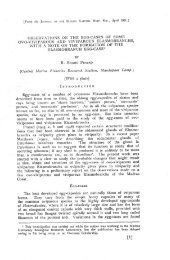PDF - Eprints@CMFRI
PDF - Eprints@CMFRI
PDF - Eprints@CMFRI
You also want an ePaper? Increase the reach of your titles
YUMPU automatically turns print PDFs into web optimized ePapers that Google loves.
106<br />
acropora 191 4, MATfHAJ, 102; pis. 25/ 1, 3; 26/4(?); 1311 (synonymy).<br />
lobora 1857, MILNE EDWARDS (& HAIME). 434: pI. 08/ 1.<br />
1879, KLUNZING ER 1, l1 : p l~ 119: 10/8.<br />
1888. ORTMANN, 171.<br />
OrbicellD lobara 1906, v. MARENZELLER, 87.<br />
Fouia pseudostelligera 1971. CHEVA LIER, 169; pis. 18/ 3.7: 19/ 1 (synonymy),<br />
18 specimens are placed under this species. They all show the typical hillocky growth. The corallites<br />
(except in X2 : 3- 22) range from 2.5 to 3 mm in diameter with a toral of 20 to 24 septa. In X2: 3- 22<br />
the corallites are 3 to 5 mm in diameter, the total septa range from 24 to 36 , thus agreeing to F. pseudostelligera.<br />
In all the specimens t he calices are circular, wa ll o nly slighrly projecting, and they are ge nerally<br />
not more than I mm deep. Other details agree to MA TTHAI 'S (1914) description of his F. acropora (= stelligera)<br />
.<br />
Mater ial:<br />
Gulf of Aqaba: T. Aviv IS E55 /548f (Eilat); 4979 (Dahab).<br />
Basel PW 71359 (Eilat); 7 3708 (EI Kura) ; 71357 (without locality).<br />
Northern R. S. : USNM Wa 57, 58 (G hardaqa).<br />
HLM X2 : 3- 22,40, 41 (Gubal lsl.).<br />
Central R. S. :<br />
481 (Ras Abu Suma) ; 306, 307 (Ras Abu Hagar).<br />
EC<br />
P. Sud. Sa 36 (Sanganeb R.).<br />
HLM RM 48 ,88,89 (Wingate R. ).<br />
Southern R. S.: HLM X2 : 10- 15 (Sarso Isl.).<br />
Di s t rib ut i 0 n : Red Sea; Aldabra (ROS EN, 1971); Madagascar (PI CHO N, 1964); Chagos; Maldives;<br />
Lakshadweep ; Gul f ofMannar(PI LLAI , 1972); Ceylon; Nicobar Isis. ; Cocos-Keeling Isis. (VAUGHAN , 1918);<br />
East Indies (UMSGROVE, 1939); Japan (VASE , SUG IYAMA & EGUCHI, 1936); Palau Isis.; Great Barrier<br />
Reef (CROSSLAND , 1952) ; New Hebrides; New Caledonia; Marshall Isis. (WELLS, 1954); Fiji ; Samoa;<br />
Fanning Isis.; Hawaii ; Cook Isis. (STODDART & PILLAI, 1973); Tahiti (CROSSLAND , 1931); Tuamotu<br />
Archipelago.<br />
Orbicellil<br />
Favia<br />
Plesiastretl<br />
Favia<br />
Favia laxa (KLUNZ ING ER), 1879<br />
(Plale 26. Figs. 7, 8)<br />
Jaxa 1879, KLUNZINGER 3. 49: pis. 5/ 3; lO/9a, b (Type locality : Red Sea).<br />
1906. v. MARENZELLER, 87.<br />
/aXQ 19 14 , MAITHAI. 99: pis. 24/5.6: 31/2.<br />
1972. WIJSMAN·BEST, 25 : pI. 4/4.<br />
1974, WIJSMAN·BEST, 256: pI. 412.<br />
1974, MERGNE R & SCHUHMACHER, 264.<br />
1977. VERON. PICHON & WIJ SMAN-BEST, 21 . figs. 23 - 27,415 .<br />
1980. HEAD. 151 . 456.<br />
'":co 1971 , LOYA & SLOBODK IN, 124.<br />
onanas? 1914, MATfHAI.98;pls. l012. 4 ; 2SI7 (synonymy),<br />
We have seven specimens before us which we assign to this species. Two of them (RM 80 and PW 7 3694)<br />
show almost similar details and are described rogether. Submassive, hemispherical. Corallites circular or<br />
elongated. Calices 4 to 6 mm in greater diameter, elongated o nes showing signs of division. Wall elevated<br />
1 to 2 mm. Dista nce between adjacent corallites 3 to 4 mm, depth 2 to 3 mm. Intercorallite grooves<br />
often visible. Total septa 28 to 32 , of which 18 ro 20 fuse with the columella. Larger septa with a paliform<br />
lobe. Ge nerally only two subsidiary septa rurn toward s a major seprum. Larger septa up to I mm exsert,<br />
edges dentate, sides granular. Costae conspicuous, those of the opposite sides unite at the middle of the<br />
intercorall ite furrow over a transverse ridge.<br />
PW 71 354 is encrusting. The coraUites and calices are nearly rounded, average 6 mm in diameter,<br />
wall 2 mm exsert, adjacent coraUites 4 ro 5 mm apart. Peritheca with blisters. Septa 35 to 40, 13 to 20<br />
reach the columella. Septa exsert and slightly swollen at the wall. Paliform lobes prominent. Columella<br />
2 to 3 mm in diameter, composed of closely twisted trabeculae to which major septa join. Costae unite at<br />
the middle o f the intercorallite area. In none of t he specimens full y developed buds are preserved .
















